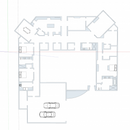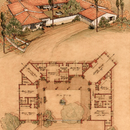Solving the Challenges of This Plumbing Design
I’ve been trying to adapt (using the SketchUp program) a 1936 Cliff May hacienda design for a new house I want to build in SoCal. The courtyard design is great, but the “U” shape makes for some long hot water runs. How/where would you put hot water tanks in this design? I had considered a mechanical pit/basement, but would like to avoid that for cost issues/not knowing what is under the building pad (giant boulders are a possibility). Area is limited to propane for gas, so I am planning on two heat pump electric water heaters. Don’t like tankless, or recirculating lines. I have some thoughts, but would appreciate any creative ideas to solve this problem. Any other input on this design (on any aspect of it) would be welcome. Also, this will have an unvented attic (within the house thermal envelope) and the plan is to put the HVAC and ducts up there (at the corners where the wings meet the main volume). Eventually, I will go to an architect/engineer with this, but I want to work out the bugs on my own first.
GBA Detail Library
A collection of one thousand construction details organized by climate and house part











Replies
SoCal, I think the heat pump water heaters would be perfectly suited.
There's no rule that says you have to have only one hot water system. I'd put one water heater in each leg of the L, and have it supply water to only that leg.
I would put the water heaters either in the room off of the garage or in one of the closets. I'd put a return to the HVAC in the room with the water heaters, and a vent out to the hall. So hall air is being pulled into the room from the hall and exchanged for air that has been through the heat pump.
Excellent ideas, thank you!
I would normally say try to avoid plumbing fixtures on exterior walls, but I suppose in SoCal you don't have the same winter issues that we have up here in the frozen North :-)
I see no reason not to run two water heaters with two seperate hot water "zones". If you have showers/bathtubs in both of those bathrooms at the opposite ends of the house, put one water heater near each and enjoy not having one shower-er use up all the hot water before the other shower-er can get in themselves. In this type of system, I'd just try to balance the loads out so that you don't have a situation with one water heater running 90% of the house and the other one only running a single sink (a bit extreme of an example, but it makes the point). Ideally you want both water heaters to make about the same amount of hot water when averaged over some period of a day or two.
Bill
Thanks Bill, planning on two (even thought about three, but it seems ridiculous - one for each wing, and one for the kitchen/powder), question is where do I put them, what's the longest run I can do without resorting to recirculating lines. Also don't want to use tankless heaters.
Long lines just make for a wait before you have hot water at the fixture. Longer lines = longer waits. Really long lines will also make for a slight drop in hot water temperature too, but that shouldn't really matter much.
Recirculating lines have an associated energy hit, since they do increase standby losses, but you might find that most of that is cancelled out by losses for a second hot water heater too. I wouldn't put a third hot water heater just to avoid a recirculating loop.
BTW, you can calculate the wait time for hot water for a given line length. You need to know the flow rate and the enclosed volume of the pipe to do this. Divide the enclosed volume of the pipe by the flow rate, that will give you the time to purge all the cold water in the pipe. Once the cold water is out, you get hot water.
Bill
Use as small as possible home run lines and under-sink heaters where usage is low.
I'm curious - why the aversion to recirculating lines (with on demand pumping)? It should be cheaper and faster than more tanks.
I have a recirculating pump/lines in my current house, and the pumps have failed multiple times over the years and I finally gave up replacing them. Also don't like the idea of water continually running through the lines. Maybe an on-demand system is the answer, I had not considered that as an option...
I know of a house with a recirc line somehow wired to the light fixtures. When any bathroom tub or shower light is turned on, or a foot pedal under the kitchen sink cabinet is pressed, the recirc pump runs for 2 minutes then shuts off.
The electric circuit that triggers the recirc pump is probably activating a timer, which then runs the pump for a set period of time before shutting off. These timers are commonly available from places like Grainger. They are usually known as "time delay relays", and have a knob (or buttons) on top to adjust the time delay.
Bill
I built my house with on demand recalculating for the hot water.
When I want hot water I turn on any hot water faucet for a few seconds then turn it off, I go do something else for a minute or so and when you get back I have hot water waiting for me from the heater that is 50 feet away. With next to no wasted water. Some times I happen to draw hot water by mistake and needlessly heat the loop it costs about 12 cents to heat the loop.
https://www.fasterhotwater.com/Tank%20style%20circulation%20pump%20Dedicated%20Return%20Line.shtml
Walta
Thank you Walter, that's an excellent idea...
Take a look at the D'Mand products from Metlund. Their basic concept is a "smart" pump with a temperature sensor on the return side of the recirc loop. The pump is activated by a low-voltage button at the point of use (think doorbell button). When activated, the pump starts and runs until warm water returns through the loop to the pump, then it shuts off automatically. We had one in our last house and it took about 30 seconds to fill the longest loop. They've also got options to interconnect the activation with the room lights (great for bathrooms), wireless actuators, probably some others. With the very short run times and decent quality pumps, they last forever. Saves water and energy.
I'd consider putting the left-wing WH in the garage. Keeps the noise out of the bedroom area, provides some cooling/drying to the garage, and with the heat in SoCal, provides nearly free hot water. Considering SoCal climate, I'd even consider putting the right-wing WH in a closet outside, or at least in a sound-insulated closet that communicates only with the outside. These units are not loud, but they're not all that quiet either.
Excellent info Peter, thank you! Will check out the Metlund system. I like the ideas for the location also. I have been considering a bump out with an exterior access for the location. The longest run in that design would be the kitchen at nearly 70'. My favorite solution was an underground mech pit or basement, but they are not common here, and I'm afraid a contractor would not be competent at getting it watertight, and the possibility of a difficult and expensive excavation is significant. What would you consider to be the longest run you would accept without any recirculation system? 40-50'? Less?
>"What would you consider to be the longest run you would accept without any recirculation system? 40-50'? Less?"
Larger diameter runs should be shorter in length to meet the same "time to hot" needs, so diameter is important too.
I would decide on what time you think is reasonable to weight for hot water, then use the fixture flow rate and enclosed pipe volume to work out what the maximum allowable pipe length is for any particular pipe diameter to still meet your "time to hot" spec.
Bill
There's no real answer to that. It depends on how much water you want to throw away. The on-demand recirc. is nice because it saves all of the water in the trunk lines, and all you throw away is a cup or so of water if you keep the branches short. You should also consider the actual use of the water at the end of the line. In a kitchen, you use hot water for washing hands and dishes at the sink, and (sometimes) to feed the dishwasher. Modern dishwashers use only a gallon or so of water, and most plumbing systems don't deliver hot water until you've wasted more than that. So dishwashers have their own heating elements. It's just resistance heat, but there's so little of it that feeding cold water to the D/W is actually a good option in many cases. That leaves the sink. If you put most of your dishes in the D/W (you should), you don't actually have much demand for hot water at the kitchen faucet. A 5 gal. electric W/H hidden under the counter might do the job so you can skip running hot water to the kitchen at all.
Thanks Pete, I like the idea of a small kitchen dedicated water heater…I’m comfortable with the lines running 25 feet or so, beyond that and it’s probably one of those things that would be a constant source of annoyance.
Kurt,
I am using the D'Mand system that Peter mentioned (although if you search Metlund, the results will show ACT, which is the company I have been dealing with). I am using a single S3 pump that for 2 recirc loops. 1 of the runs is much longer than the other so I have the shut-off valve on the shorter loop partially closed so that it does not shut off the pump before the longer loop gets hot water. I am using their LED Decora style contact switches that light up when the pump is running. I placed each switch in a 2-gang box along with the ERV Decora style boost switches so it is nice clean look. The tech support at ACT is really good. I have contacted them a few times and have been very satisfied with the advice they have given me.
Thank you Jonathan!